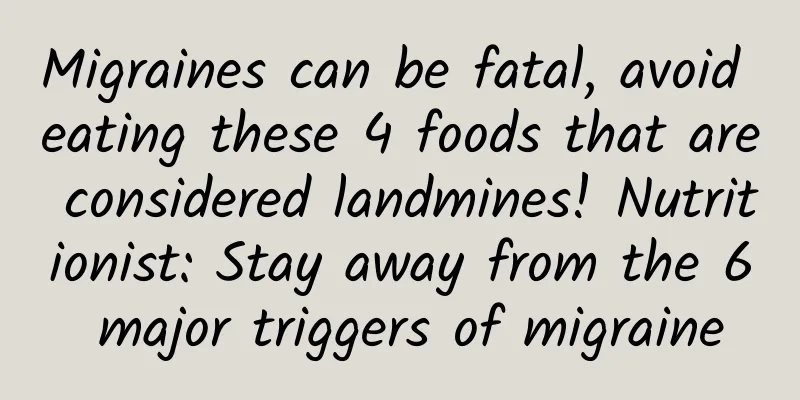Migraines can be fatal, avoid eating these 4 foods that are considered landmines! Nutritionist: Stay away from the 6 major triggers of migraine

|
"Headache is not a disease, but it can be fatal"! In particular, migraine is a type of headache that is related to blood vessels and neurotransmitters. Once an attack occurs, symptoms such as nausea, vomiting, fear of light, fear of noise, etc. may occur, which can really make people feel miserable. Nutritionists say that if you want to get rid of the threat of migraines, according to scientists' research, you should try to avoid the four major landmine foods in your daily life and stay away from risk factors that may trigger migraines. Migraine is a pulsating pain, not necessarily one-sided pain Migraine is different from common headaches. It usually only occurs on one side of the head (left or right), and is a "pulsating" pain that is consistent with the rhythm of the heartbeat or pulse, that is, it has a regularity like the pulsation of blood vessels. Although the pain is usually on one side of the head, it is also common to feel pain in the forehead, sides, top of the head, back of the head, and behind the eye sockets. Migraines may also be accompanied by a number of neurological symptoms In addition to the common symptoms of nausea, vomiting, fear of light, and fear of noise, migraine attacks may also be accompanied by many neurological symptoms, such as visual symptoms, blurred vision in one or both eyes, visual field defects, flashing spots or lines, and changes in the shape of objects. Therefore, the diagnosis of migraine must be based on a detailed neurological examination and a differential diagnosis of the various causes of headache. In addition to the common symptoms of nausea, vomiting, fear of light, and fear of noise, migraine attacks may also be accompanied by many neurological symptoms, such as visual symptoms, blurred vision in one or both eyes, visual field defects, flashing spots or lines, and changes in the shape of objects. Avoid these 4 foods that can cause migraines Nutritionist Li Wanping said that in order to stay away from migraines, in addition to seeking medical treatment, it may also be helpful to reduce possible triggering factors in life. Here are four foods that scientists say you should avoid: 1. Cheese: Especially refers to the types that have been matured, such as white mold cheese, blue cheese, cheddar cheese, or the common hard cheese made into huge round balls. Scholars believe that this is related to the high tyramine content. 2. Processed meat products: Processed meats that have been cured, including hot dogs, ham and bacon, contain additives such as nitrates and nitrites, which will cause blood vessels to dilate and cause headaches. 3. Coffee: For some people, caffeine is a trigger for migraines; but for some people it can provide relief, especially when people who are used to drinking coffee every day suddenly stop drinking it, which can cause headaches due to caffeine withdrawal. Studies have shown that consuming as little as 100 mg of caffeine per day can cause withdrawal symptoms. Therefore, migraine patients who frequently drink coffee or other high-caffeine beverages should try to limit or gradually reduce their intake. 4. Alcoholic Beverages: In addition to alcohol itself causing vasodilation and leading to migraines, some researchers believe that certain substances in alcoholic beverages, such as histamine, tyrosine, and sulfites, may also be the cause. Some studies have even found that red wine and beer appear to trigger migraines more than other alcoholic beverages. Migraine sufferers who regularly drink coffee or other high-caffeine beverages should try to limit or gradually reduce their intake. In addition, there have been case reports suggesting that some people have experienced migraine reactions to aspartame in zero-calorie colas, MSG used in cooking, or chocolate and citrus fruits. If you suspect that certain foods or drinks may trigger your migraines, you may want to exclude them from your diet. It is recommended that you try not eating them for a while to see if the situation improves. Then try to consume them in small amounts. If your migraine symptoms recur, there is a high chance that the food is causing the problem. Also, be careful not to eliminate all possible headache-causing foods at once. Eliminate only one at a time, otherwise it will be difficult to determine which food is causing the reaction. 6 common causes of migraine 1. Specific foods: Chocolate, MSG, alcohol, artificial sweeteners, etc. 2. Environmental changes: Changes in weather, seasonal temperature, or air pressure may also trigger migraines. 3. Odor stimulation: Especially strong smells, including perfume, second-hand smoke and other irritating smells. 4. Lack of sleep: Clinically, it has been found that lack of sleep or changes in sleep patterns may also cause migraines. 5. Impact of light and sound: External stimuli such as too bright light or too much noise may also trigger a migraine attack. 6. Stressful emotions: In daily life, such as family and work, being under great pressure, or emotional disorders are also triggers of migraine. Diet is not the only answer to improving migraines. Changes in seasonal weather or hormones, external stimuli such as too bright lights or noise, and stress are all migraine triggers, and they vary from person to person. When migraines have affected your daily life, it is still important to see a doctor for diagnosis. Nutritionist Li Wanping reminds us that diet is not the only answer to improving migraines. Changes in seasonal weather or hormones, external stimuli such as overly bright lights or noise, and stress are all causes of migraines, and they vary from person to person. When migraines have affected your daily life, it is still important to see a doctor for diagnosis. The most important thing in treating migraine is to avoid the triggers mentioned above. As for drug treatment, it can be divided into: "analgesics for acute attacks" and "preventive medications." If headaches are not frequent and do not reach the level of disability, you can first make adjustments to your lifestyle (such as regular exercise, adequate sleep, head protection, etc.), and then use painkillers to relieve occasional attacks. If the frequency of headache attacks reaches more than twice a week, you may be able to start taking "migraine preventive medication" after evaluation by a doctor; this preventive medication, after being taken continuously for a period of time, can effectively reduce the number of headache days and reduce the use of painkillers during acute attacks. |
Recommend
Why can’t I lose weight? It turns out that eating these things messes up hormones
The reason why you can’t lose weight may be that ...
What causes abdominal distension during menstruation?
What causes abdominal bloating during menstruatio...
High fiber eliminates fatty liver, don't eat high GI fruits by mistake
Still eating and drinking? Modern office workers ...
Experts introduce relevant knowledge about acute pelvic inflammatory disease
Many female friends may have heard of acute pelvi...
What to eat after uterine fibroid surgery How to take care of the diet after uterine fibroid surgery
Uterine fibroid surgery should adopt different tr...
Why do unmarried people also suffer from pelvic inflammatory disease?
It is also very important for unmarried women to ...
Cancer patients eat zongzi with alternative ingredients, Nanshi Hospital sends a zongzi
The Dragon Boat Festival is approaching, and vari...
What is bacterial vaginosis
Bacterial vaginosis is a disease that is difficul...
Thousands of people plant rice in 2 hectares of rice fields to challenge the Guinness World Record
Taiwan's rice is of excellent quality. Domest...
What is the best way to treat menopause?
Every woman will experience menopause, so you sho...
How to prevent cervical hypertrophy?
If cervical hypertrophy is not treated in time, i...
It's very wet down there, usually a few days after menstruation
Women's feeling of vaginal moisture cannot ac...
What is the impact of uterine fibroids on women's pregnancy?
The impact of uterine fibroids on pregnancy is on...
The central government has conditionally lifted the ban. Hu Zhiqiang calls for respecting consumer rights.
In response to the Executive Yuan's announcem...
When it’s cold, people love to eat hotpot when they get together, but be careful of these 4 major health risks that can damage your kidneys! Doctor: 5 tips for eating hot pot healthily
Hot pot is one of the favorite foods of many peop...









